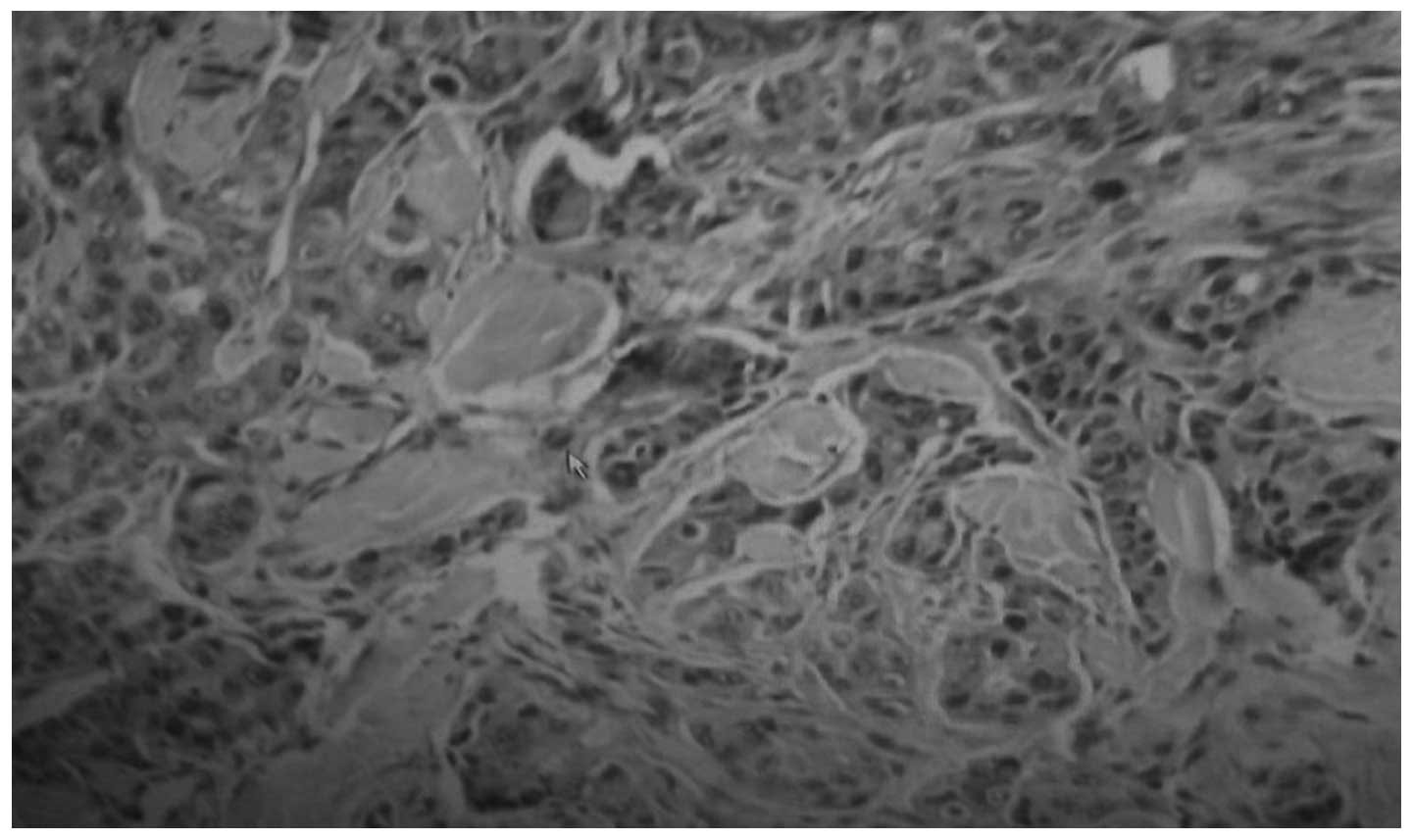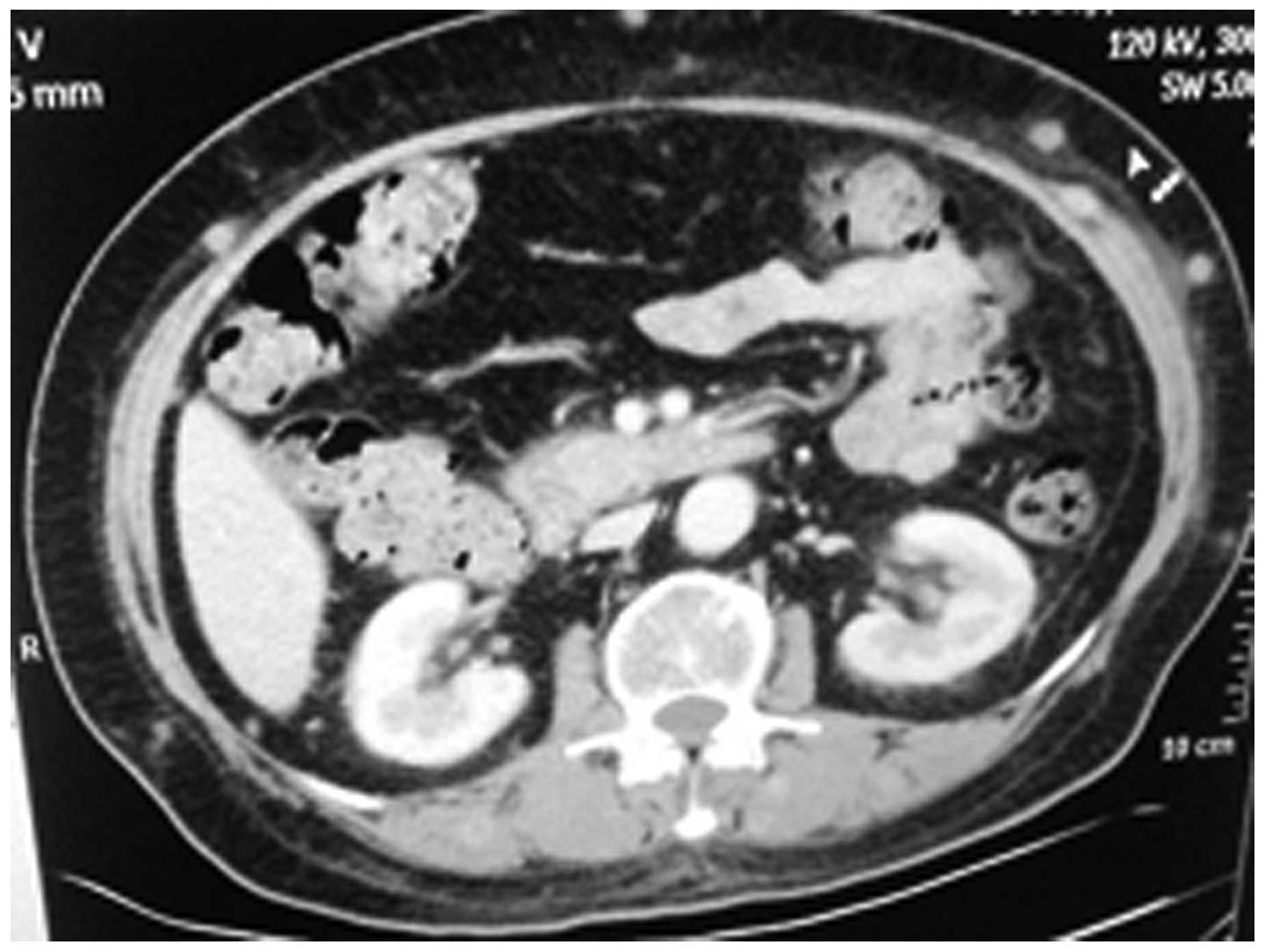Cutaneous metastatic adenocarcinoma complicated by spontaneous tumor lysis syndrome: A case report
- Authors:
- Yu Wang
- Caijun Yuan
- Xiaomei Liu
View Affiliations
Affiliations: Department of Oncology, Graduate School of Liaoning Medical University, Jinzhou, Liaoning 121000, P.R. China, Department of Oncology, The First Affiliated Hospital of Liaoning Medical University, Jinzhou, Liaoning 121000, P.R. China
- Published online on: May 23, 2014 https://doi.org/10.3892/ol.2014.2171
-
Pages:
905-907
Metrics: Total
Views: 0 (Spandidos Publications: | PMC Statistics: )
Metrics: Total PDF Downloads: 0 (Spandidos Publications: | PMC Statistics: )
This article is mentioned in:
Abstract
The present study reports the case of a 71‑year‑old female with metastatic adenocarcinoma of the skin who developed tumor lysis syndrome (TLS) upon admittance to the First Affiliated Hospital of Liaoning Medical University (Jinzhou, China). The patient presented to the hospital due to multiple subcutaneous nodules, lethargy and weakness, but succumbed without any cancer therapy. Metastases to the skin from solid carcinomas are uncommon, and several studies have reported patients with minimal primary symptoms despite extensive metastatic skin disease. However, few cases were accompanied with spontaneous TLS at the time of presentation. TLS may be a severe complication during the therapy for hematological and oncological diseases. Although spontaneous TLS in internal tumors has been reported, it is extremely rare. The present study highlights the fact that multiple subcutaneous metastases may occur with the symptoms of spontaneous TLS, and may be key for the early recognition of this syndrome.
View References
|
1
|
Savk E, Kolay A, Meteoglu I, et al:
Cutaneous metastatic adenocarcinoma arising from a malignant
sacrococcygeal teratoma in an adult. Dermatol Online J.
14:32008.
|
|
2
|
Lookingbill DP, Spangler N and Sexton FM:
Skin involvement as the presenting sign of internal carcinoma. A
retrospective study of 7316 cancer patients. J Am Acad Dermatol.
22:19–26. 1990.
|
|
3
|
Lookingbill DP, Spangler N and Helm KF:
Cutaneous metastases in patients with metastatic carcinoma: a
retrospective study of 4020 patients. J Am Acad Dermatol.
29:228–236. 1993.
|
|
4
|
Kalmykow B and Walker S: Cutaneous
metastases in breast cancer. Clin J Oncol Nurs. 15:99–101.
2011.
|
|
5
|
Chapman-Fredricks J, Blieden C, Sandoval
JD, Ernani V and Ikpatt OF: Acute spontaneous tumor lysis syndrome
as the initial presentation of ALK-positive diffuse large B-cell
lymphoma. Appl Immunohistochem Mol Morphol. 22:317–321. 2014.
|
|
6
|
Locatelli F and Rossi F: Incidence and
pathogenesis of tumor lysis syndrome. Contrib Nephrol. 147:61–68.
2005.
|
|
7
|
Vodopivec DM, Rubio JE, Fornoni A and Lenz
O: An unusual presentation of tumor lysis syndrome in a patient
with advanced gastric adenocarcinoma: case report and literature
review. Case Rep Med. 2012:1–12. 2012.
|
|
8
|
Charalambous C, Zipitis CS and Midwinter
M: Gastric adenocarcinoma metastatic to the skin: a report. Eur J
Cancer Care (Engl). 11:143–144. 2002.
|
|
9
|
Sun J, Gao Q and Fan VT: Multifocal
cutaneous metastases from squamous cell carcinoma of hard palate.
Int J Oral Maxillofac Surg. 41:807–809. 2012.
|
|
10
|
Tufan A, Unal N, Koca E, Onal I, Aksu S
and Haznedaroglu I: Spontaneous tumor lysis syndrome in a patient
with diffuse large B cell lymphoma and Richter syndrome. Ann
Hematol. 85:183–184. 2006.
|
|
11
|
Altman A: Acute tumor lysis syndrome.
Semin Oncol. 28(2 Suppl 5): 3–8. 2001.
|
|
12
|
Sklarin NT and Markham M: Spontaneous
recurrent tumor lysis syndrome in breast cancer. Am J Clin Oncol.
18:71–73. 1995.
|
|
13
|
Woo IS, Kim JS, Park MJ, et al:
Spontaneous acute tumor lysis syndrome with advanced gastric
cancer. J Korean Med Sci. 16:115–118. 2001.
|
|
14
|
Feld J, Mehta H and Burkes RL: Acute
spontaneous tumor lysis syndrome in adenocarcinoma of the lung: a
case report. Am J Clin Oncol. 23:491–493. 2000.
|
|
15
|
Jasek AM and Day HJ: Acute spontaneous
tumor lysis syndrome. Am J Hematol. 47:129–131. 1994.
|
|
16
|
Hsu HH, Chan YL and Huang CC: Acute
spontaneous tumor lysis presenting with hyperuricemic acute renal
failure: clinical features and therapeutic approach. J Nephrol.
17:50–56. 2004.
|











